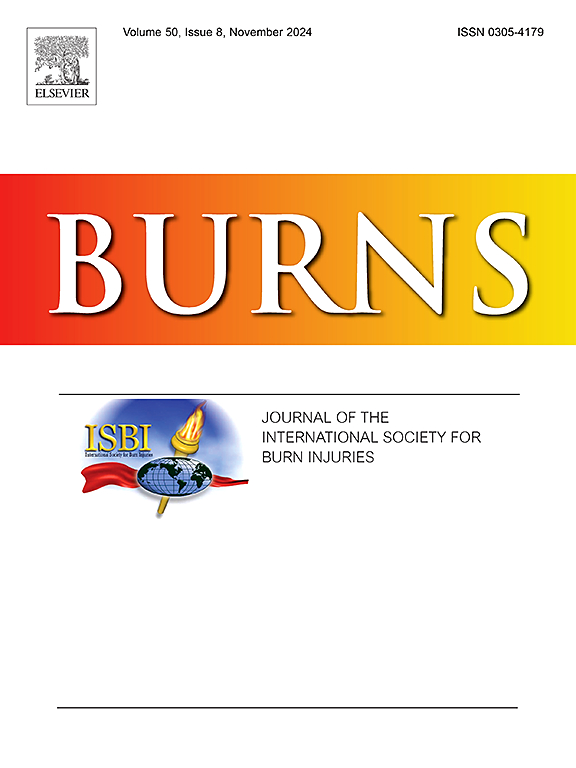Enablers and barriers to participation in physical activity programs while hospitalized after burn injury: The patient perspective
IF 2.9
3区 医学
Q2 CRITICAL CARE MEDICINE
引用次数: 0
Abstract
Background
Physical activity is an essential component of burn rehabilitation; however, the patient experience of factors that contribute to physical activity participation while hospitalized after burn injury has not yet been described. This study aimed to identify enablers and barriers to participation in physical activity while hospitalized after burn injury from the patient perspective.
Methods
A qualitative descriptive study design was undertaken. Purposive sampling was used to recruit adults with burn injuries admitted to the burn center between February and July 2022. Semi-structured interviews were conducted by a research assistant not involved in clinical care, audio-recorded and transcribed verbatim. All de-identified transcripts were analyzed using an inductive thematic approach and organized into major themes.
Results
Twenty participants (18 males) with average age of 47 years and mean burn size of 13.8 % total body surface area were included. Factors which influenced patients’ ability to participate in physical activity were summarized into six major themes: 1) Burn injury factors; 2) Patient factors; 3) Staff support; 4) Family support; 5) Peer support; 6) Environmental factors. Pain, fear of causing further pain or harm and beliefs regarding the need for rest to achieve wound healing were identified as major barriers to physical activity performance. Family support and supportive care from staff were highly valued enablers.
Conclusion
This is the first study to describe the patient experience of physical activity participation while hospitalized after a burn injury. Understanding the patient perspective is integral to developing appropriate multi-component interventions to promote increased physical activity early after burn injury.
烧伤后住院期间参加体育活动计划的有利因素和障碍:患者视角
体育活动是烧伤康复的重要组成部分;然而,在烧伤后住院期间,患者对促进身体活动参与的因素的经验尚未得到描述。本研究旨在从患者的角度确定烧伤住院期间参与体育活动的促进因素和障碍。方法采用定性描述性研究设计。采用有目的抽样的方法招募2022年2月至7月期间入住烧伤中心的烧伤成人。半结构化访谈由一名不参与临床护理的研究助理进行,录音并逐字转录。使用归纳主题方法分析所有去识别的转录本,并组织成主要主题。结果共纳入20例患者,男性18例,平均年龄47岁,平均烧伤面积13.8 %。影响患者参与体育活动能力的因素可归纳为六大主题:1)烧伤因素;2)患者因素;3)人员支持;4)家庭支持;5)同伴支持;6)环境因素。疼痛、害怕造成进一步的疼痛或伤害以及认为需要休息以实现伤口愈合的信念被认为是身体活动表现的主要障碍。来自工作人员的家庭支持和支持性护理是高度重视的促成因素。结论:本研究首次描述了烧伤住院期间患者参与体育活动的经历。了解患者的观点对于制定适当的多组分干预措施以促进烧伤后早期增加身体活动是不可或缺的。
本文章由计算机程序翻译,如有差异,请以英文原文为准。
求助全文
约1分钟内获得全文
求助全文
来源期刊

Burns
医学-皮肤病学
CiteScore
4.50
自引率
18.50%
发文量
304
审稿时长
72 days
期刊介绍:
Burns aims to foster the exchange of information among all engaged in preventing and treating the effects of burns. The journal focuses on clinical, scientific and social aspects of these injuries and covers the prevention of the injury, the epidemiology of such injuries and all aspects of treatment including development of new techniques and technologies and verification of existing ones. Regular features include clinical and scientific papers, state of the art reviews and descriptions of burn-care in practice.
Topics covered by Burns include: the effects of smoke on man and animals, their tissues and cells; the responses to and treatment of patients and animals with chemical injuries to the skin; the biological and clinical effects of cold injuries; surgical techniques which are, or may be relevant to the treatment of burned patients during the acute or reconstructive phase following injury; well controlled laboratory studies of the effectiveness of anti-microbial agents on infection and new materials on scarring and healing; inflammatory responses to injury, effectiveness of related agents and other compounds used to modify the physiological and cellular responses to the injury; experimental studies of burns and the outcome of burn wound healing; regenerative medicine concerning the skin.
 求助内容:
求助内容: 应助结果提醒方式:
应助结果提醒方式:


